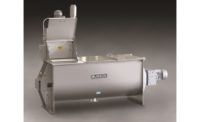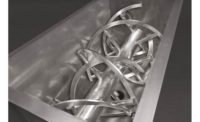Quick changeover on a ribbon blender

 Many snack and baking companies rely on ribbon blenders for batching, baking premixes, powdered flavors and other dry ingredient blends. In most plants, multiple recipes are assigned to a single ribbon blender. Therefore, quick changeovers are crucial to the overall efficiency on the production floor.
Many snack and baking companies rely on ribbon blenders for batching, baking premixes, powdered flavors and other dry ingredient blends. In most plants, multiple recipes are assigned to a single ribbon blender. Therefore, quick changeovers are crucial to the overall efficiency on the production floor.
Below are some tips to achieve fast and smooth product changeovers in a ribbon blender operation:
First, make sure that the ribbon blender is properly sized to handle the full range of bulk densities of the product line. Industry-wide, standard models are typically designed to handle densities of around 35 lb./cu. ft. (think powdered sugar, cocoa and cinnamon); more robust units are rated at 65 lb./cu. ft. or higher (raw sugar, biscuit premixes and rock salt usually fall into this density range). An undersized blender can lead to serious issues, including frequent motor overloads, excessive stress to the ribbons and spokes and eventual mechanical failure.
Agitator designs vary from one manufacturer to another, but, essentially, an agitator is a horizontal shaft with inner and outer helical ribbons. The ribbons are precisely pitched to produce radial and two-way axial flow of batch materials. Well-made ribbon blenders are fabricated with tight clearances between the U-shaped trough and the agitator tips. Product wetted parts must be well-polished, ideally with 150-grit or finer. These features promote easy cleanup, while helping to prevent the product from stagnating in any part of the blender during mixing. Adding scrapers to the ribbon agitator further minimizes material buildup along the vessel’s end walls.
Most batch-style ribbon blenders have a centrally-located discharge valve. When shopping for a new and relatively large blender, you may want to consider getting two discharge valves instead of just one. Pneumatically-operated valves also contribute to accelerating the discharge and changeover process. The type of valve you choose directly affects changeover efficiency. Dust-tight knife gate valves are used for many food applications, though they inherently contain cavities that can require thorough cleaning. Flush plug valves completely to eliminate dead spots and offer better cleanability. For wet applications, such as soups or batter, a liquid-tight valve is required.
During discharge, it’s common practice to keep the agitators running to motivate the product to move along. Since different recipes have different flow characteristics, it’s useful to have electronic speed control that can be economically provided by a simple variable-frequency drive (VFD). This would allow an operator to accurately discharge free-flowing powders and granules as easily as reluctant solids that need more encouragement to flow through the valve. A VFD also allows the agitator to rotate gently during startup as the motor gradually ramps up to speed. On a fast-paced production floor characterized by frequent changeovers, a VFD will protect your ribbon blender from unnecessary mechanical stress and promote long service life.
When blending very fine powders or sensitive recipes, bakers can avoid cross-contamination by installing lantern rings for air purging of the stuffing box where the agitator shaft enters the trough. The stuffing box is stuffed with packing material, which prevents most products from contacting and wearing the shaft. But shaft “runout” may allow small amounts of very fine materials to migrate between the packing and the shaft, potentially causing cross-contamination from batch to batch if not cleaned. Lantern rings help reduce or prevent this occurrence by maintaining a slight positive pressure of air to keep batch particles from penetrating the stuffing box. In any case, it’s important to determine which particular changeovers will require cleaning and disassembly of the stuffing box assembly.
This last tip applies to ribbon blenders that may be acquired in the future: Do not shy away from customization. Talk to your blender supplier about tailoring the blender cover to include charging ports or bag dump stations that would work best with your manufacturing set-up. You may also opt for a pneumatically-operated cover, rotary CIP (clean-in-place) spray balls or a custom control panel. When a ribbon blender services several product lines, customization becomes almost a necessity to ensure streamlined ingredient transfers, efficient discharge, easy cleanup and fast changeovers.
Author Christine Banaszek is an application engineer at Charles Ross & Son Co., manufacturer of specialty mixing and blending equipment. Banaszek received her B.S. Ch.E. from the University of the Philippines–Diliman, where she subsequently served as instructor of chemical and environmental engineering. She has published many articles and white papers on mixing and blending technologies, applications and best practices. More information about Charles Ross & Son is available at www.mixers.com.
Looking for a reprint of this article?
From high-res PDFs to custom plaques, order your copy today!





